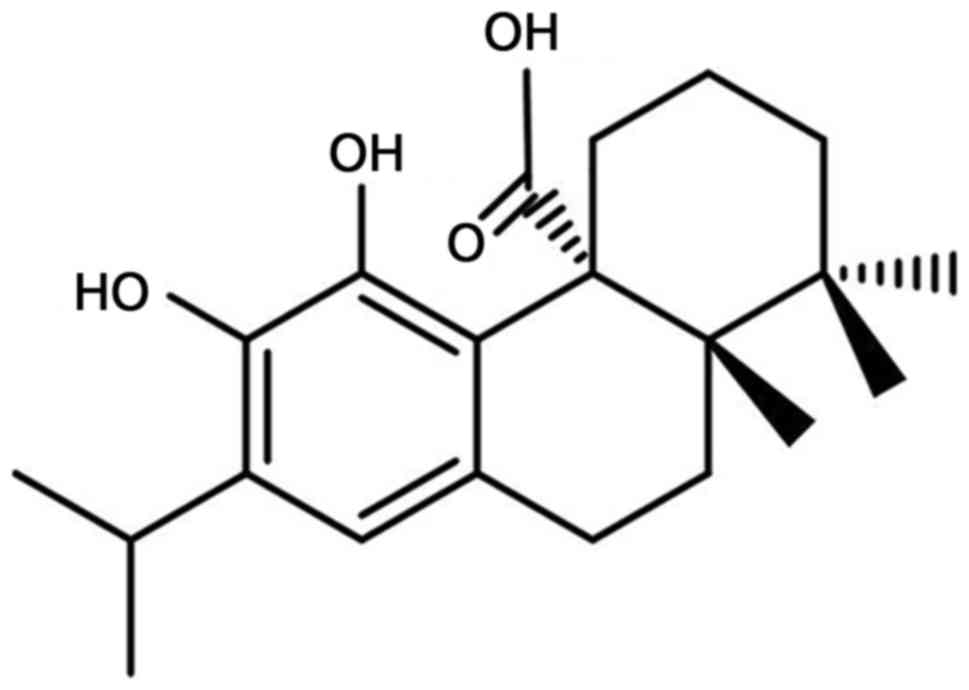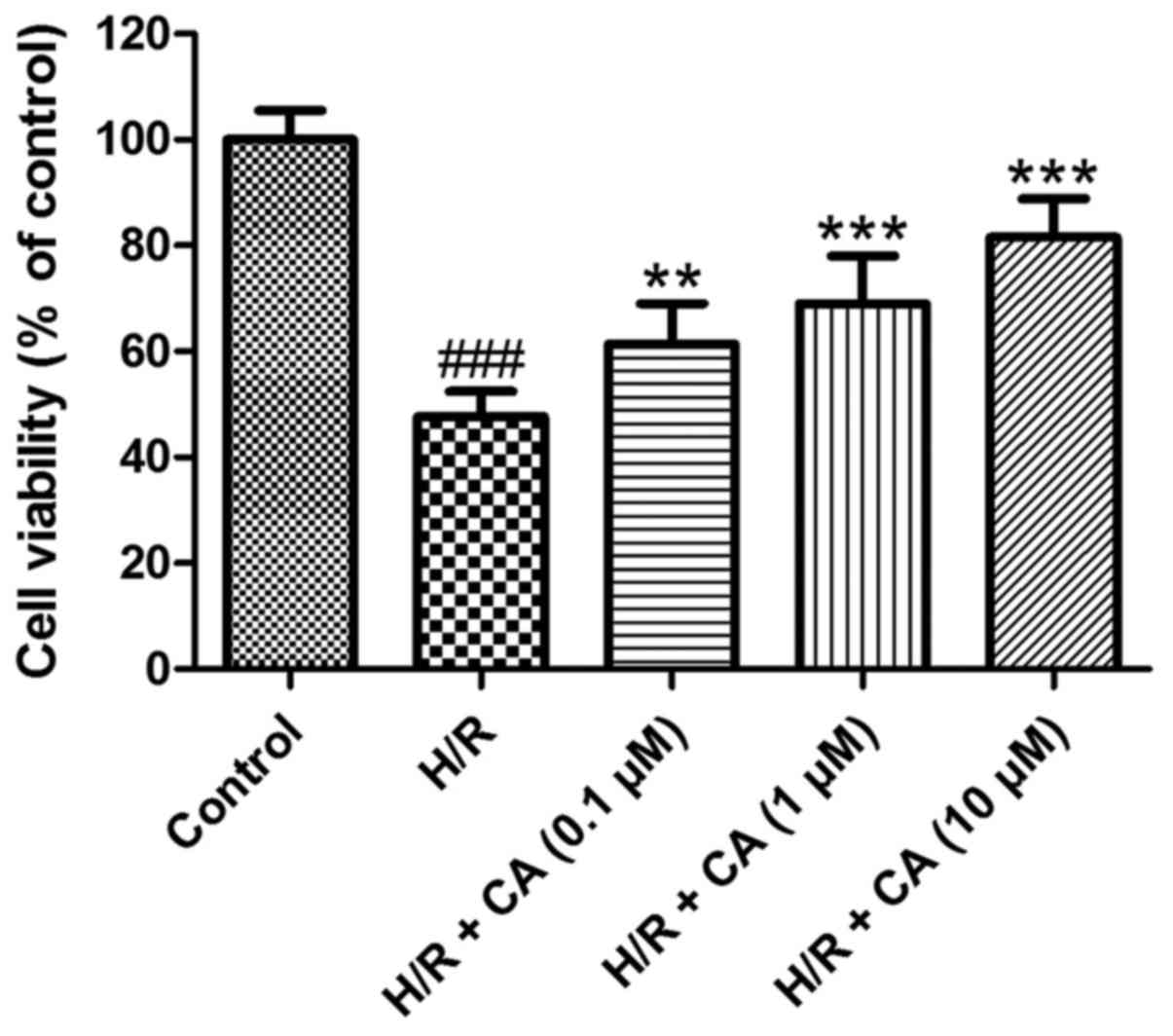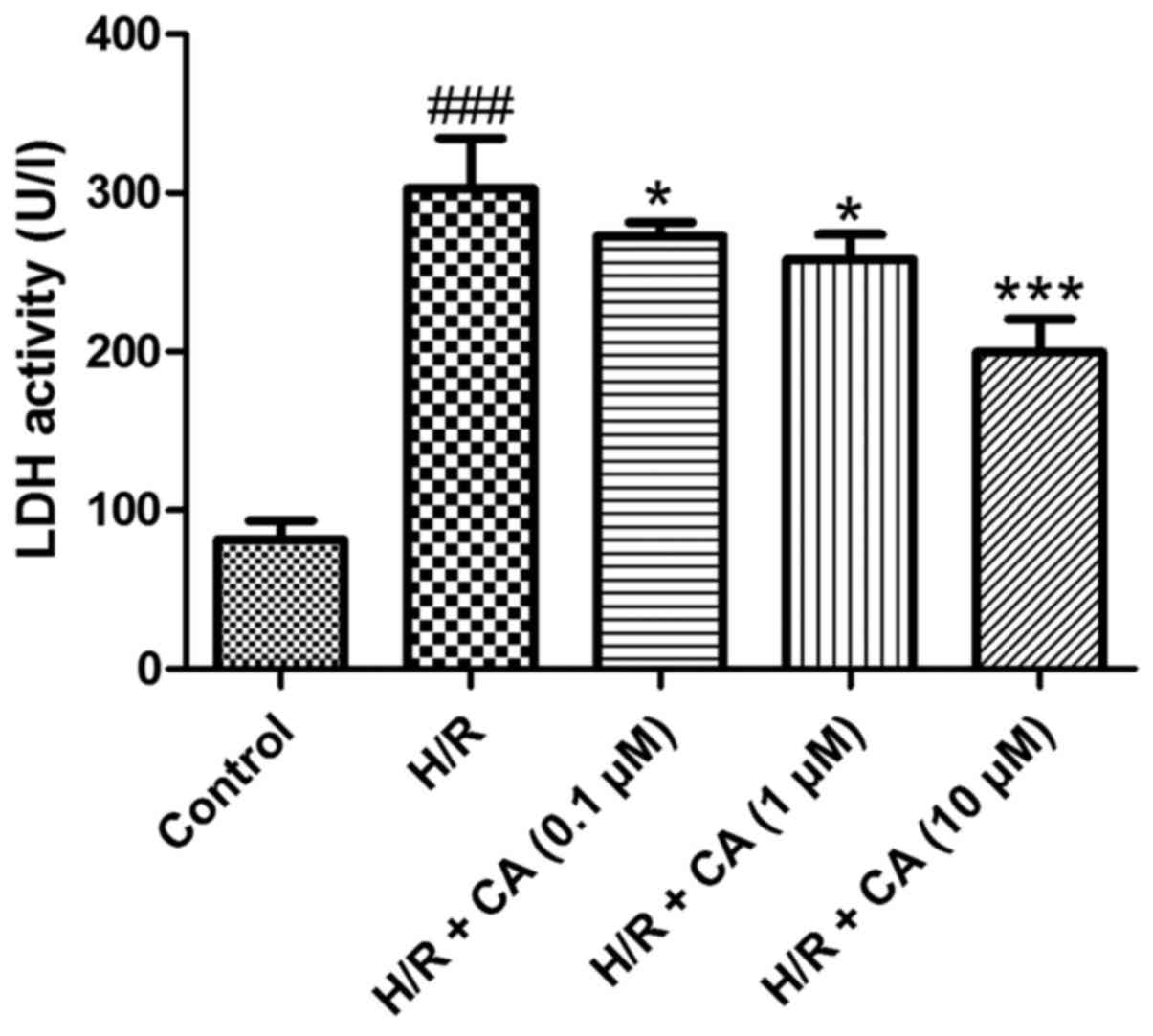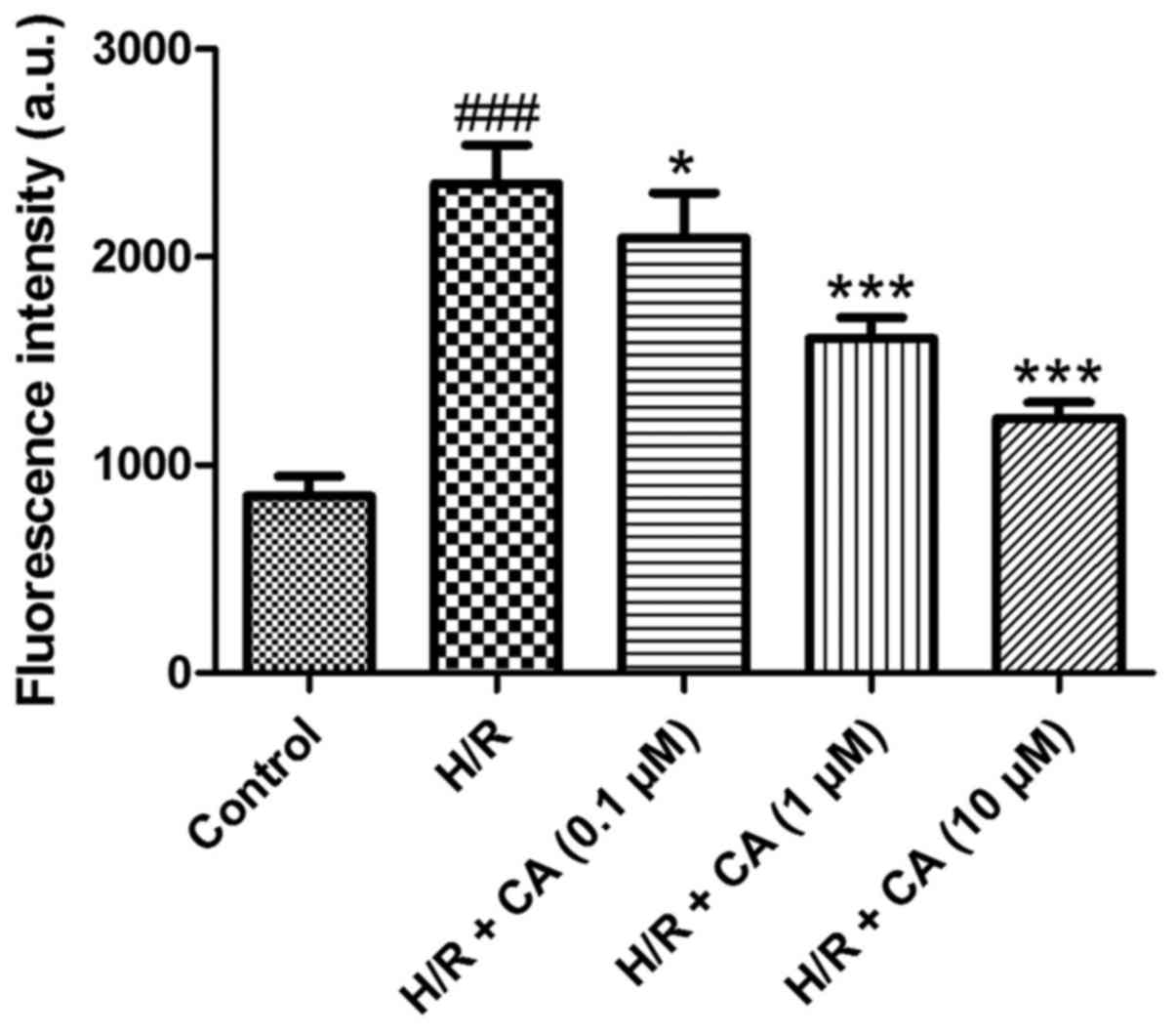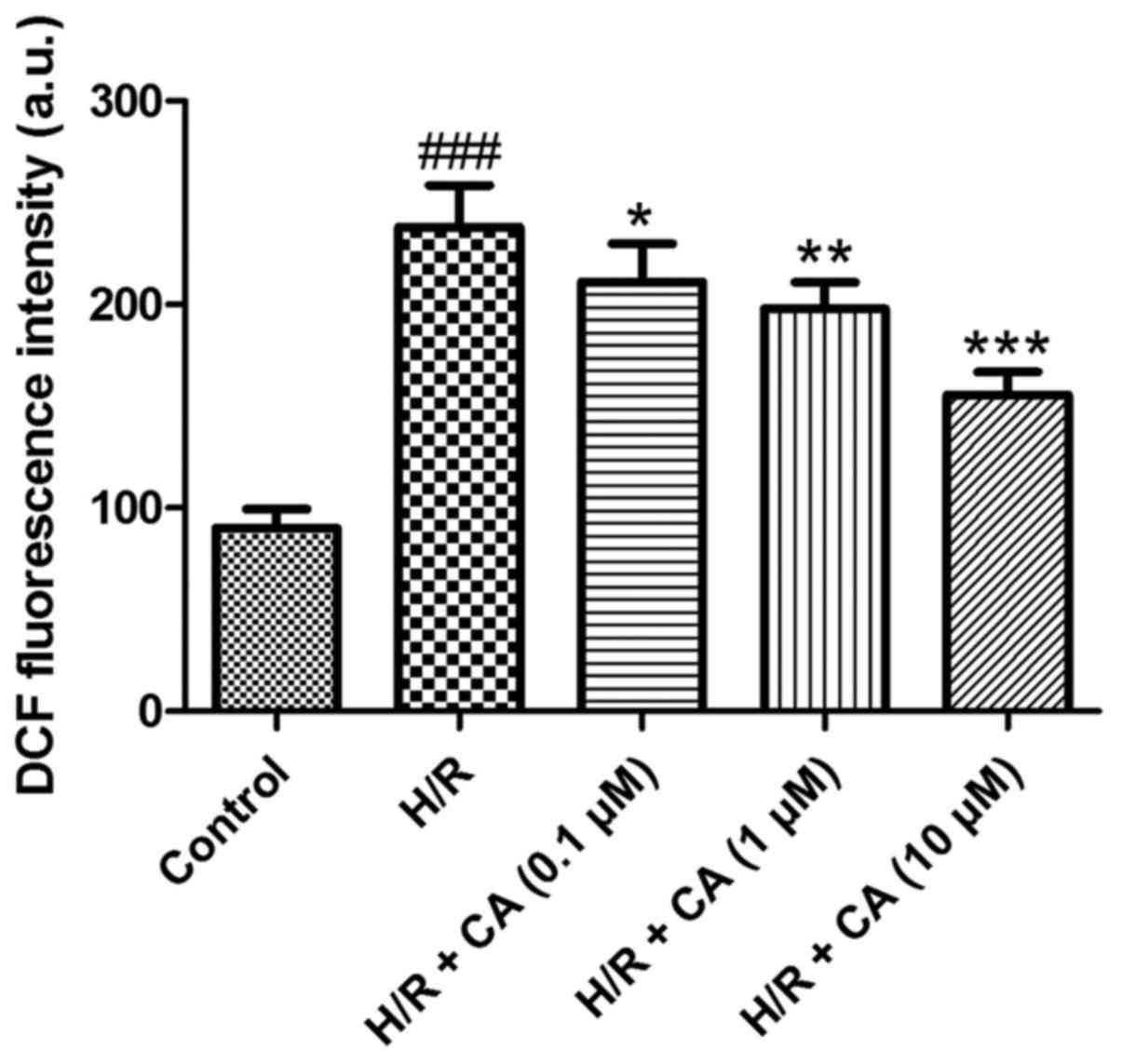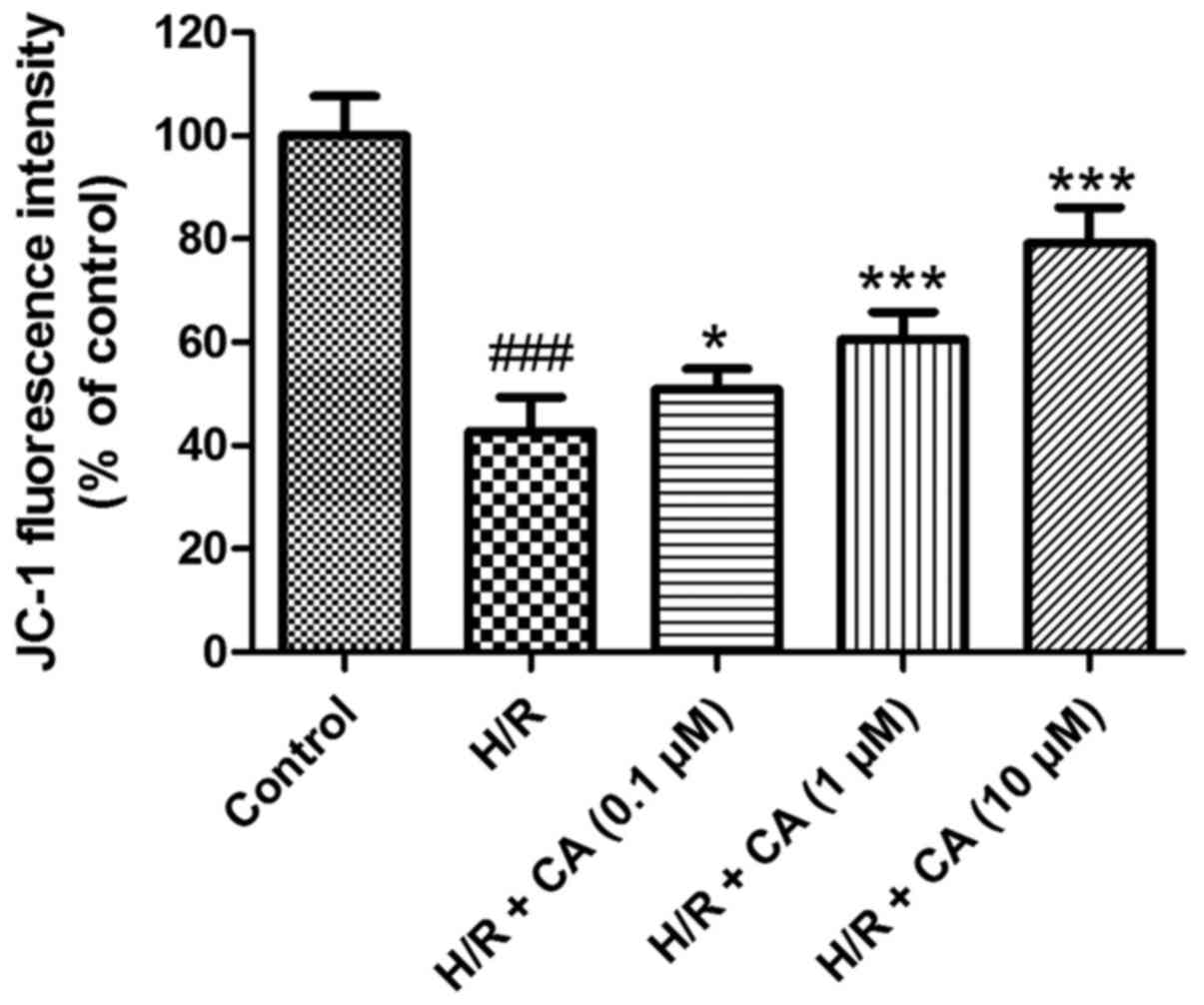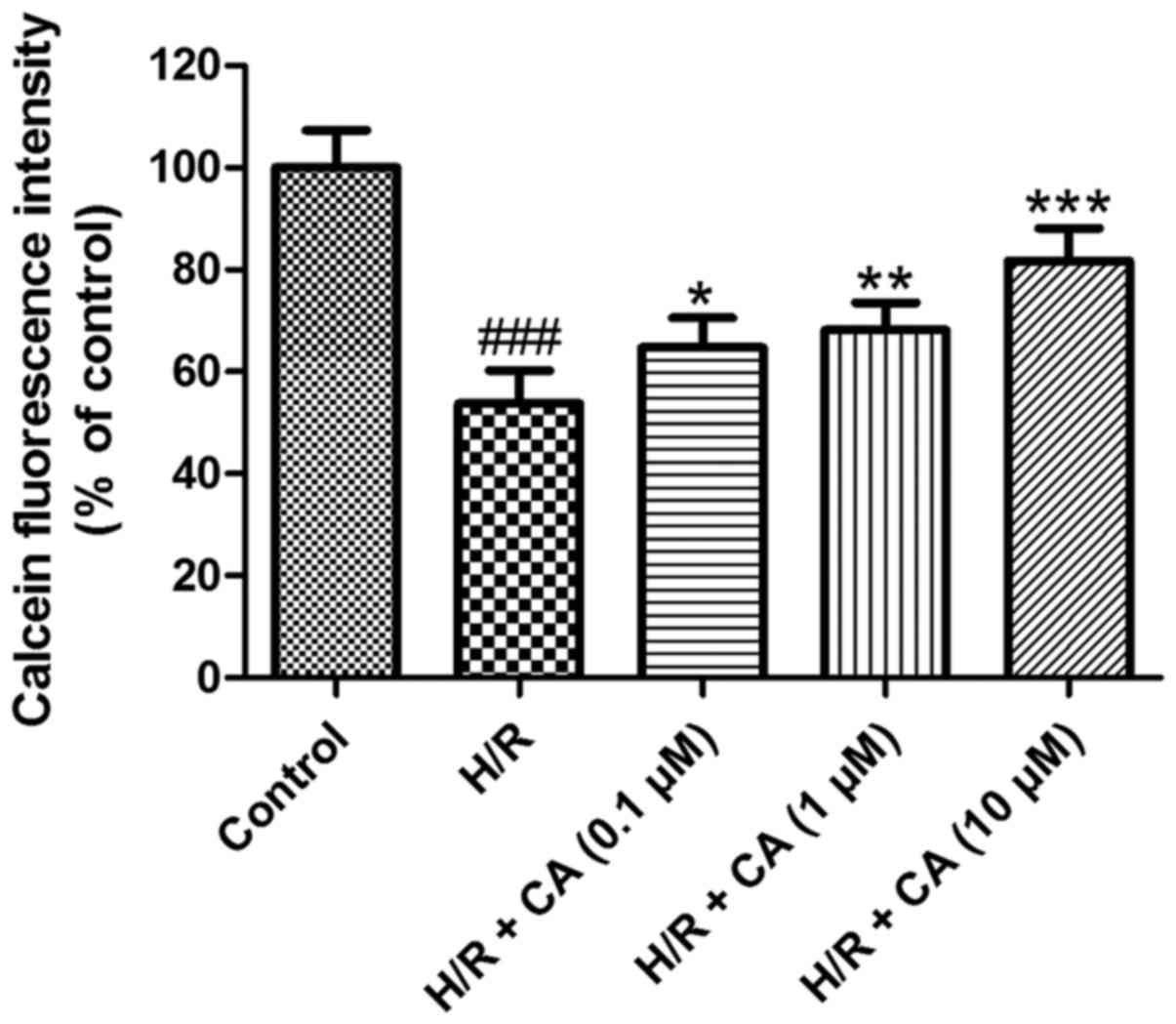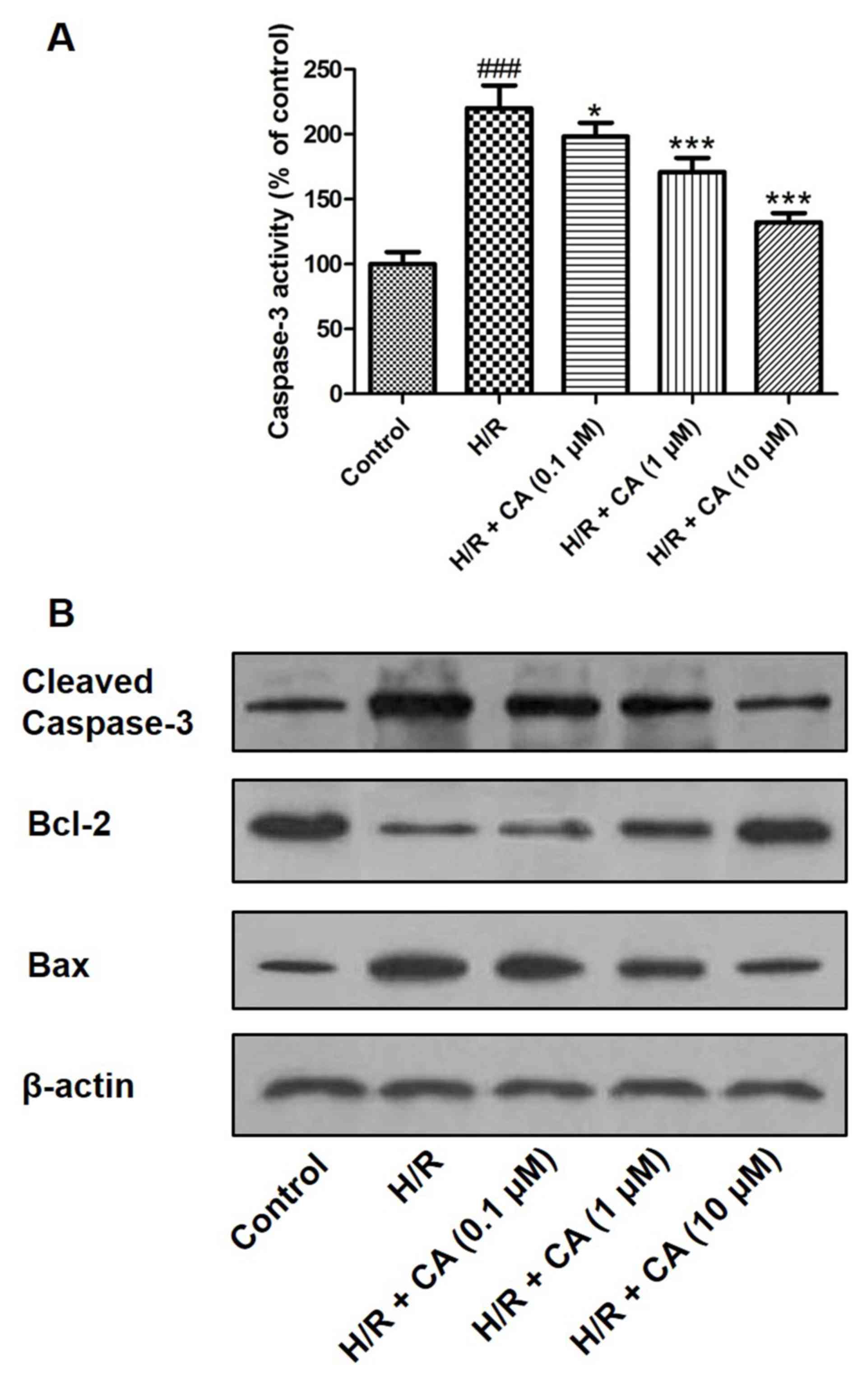Protective effects of carnosic acid against mitochondria‑mediated injury in H9c2 cardiomyocytes induced by hypoxia/reoxygenation
- Authors:
- Published online on: October 2, 2017 https://doi.org/10.3892/etm.2017.5243
- Pages: 5629-5634
Abstract
Introduction
Ischemic heart disease is one of the major causes of mortality in humans worldwide (1). The ischemic myocardium will finally lead to myocardial infarction. However, timely reperfusion exacerbates the heart failure in patients, though the infarct size has not enlarged (2). Post-ischemic reperfusion contributes greatly to the cardiomyocyte death through the mitochondria-mediated pathway (3). The mechanisms of myocardial ischemia and reperfusion injury include overproduction of reactive oxygen species (ROS), overload of intracellular calcium, collapse of mitochondrial membrane potential (MMP) and prolonged opening of the mitochondrial permeability transition pore (mPTP) among other processes (4). Natural compounds, such as berberine (5), tanshinone IIA (6) and lycopene (7), serve a pivotal role in the development of effective therapeutics for myocardial ischemia and reperfusion injury.
Carnosic acid is a natural diterpenoid (Fig. 1) that has been identified as the major bioactive phytochemical in numerous medicinal plants, including Rosmarinus officinalis (8), Salvia fruticosa (9) and Ocimum sanctum (10). Previous pharmacological studies have demonstrated that carnosic acid affords various biological activities, such as neuroprotection (11), prevention of advanced glycation end-product formation (12), attenuation of Alzheimer's disease (13), anticancer activity (14), anti-inflammation (15) and renoprotection (16). Furthermore, carnosic acid presented a cardioprotective effect in an isoproterenol-induced myocardial stress mouse model via preventing oxidative stress and apoptosis (17).
In an attempt to identify novel therapeutic approaches for myocardial ischemia and reperfusion injury, the present study assessed the myocardial protection exerted by carnosic acid and the associated underlying mechanisms using H9c2 cardiomyocytes subjected to hypoxia/reoxygenation.
Materials and methods
Chemicals and reagents
Carnosic acid was purchased from J&K Scientific Ltd. (Beijing, China). Dulbecco's modified Eagle's medium (DMEM) and fetal bovine serum were supplied by Thermo Fisher Scientific, Inc. (Waltham, MA, USA). 3-(4,5-Dimethylthiazol-2-yl)-2,5-diphenyltetrazolium bromide (MTT) and dimethyl sulfoxide (DMSO) were purchased from Sigma-Aldrich (Merck KGaA, Darmstadt, Germany). The Fluo-3 acetoxymethyl (AM), ROS assay kit, lactate dehydrogenase (LDH) activity assay kit, BCA protein concentration assay kit, MMP assay kit with JC-1, and Caspase-3 Activity assay kit, as well as the cleaved caspase-3 (cat no. AF0081), B-cell lymphoma 2 (Bcl-2; cat no. AF0060), Bcl-2-associated X protein (Bax; cat no. AF0054) and β-actin (cat no. AF003) antibodies, were obtained from Beyotime Institute of Biotechnology (Nantong, China). Calcein-AM was obtained from Dojindo Molecular Technologies, Inc. (Kumamoto, Japan).
Cell culture and model establishment
Rat H9c2 cardiomyocytes were obtained from the Cell Bank of the Chinese Academy of Sciences (Shanghai, China) and cultured in DMEM containing 10% fetal bovine serum, 1% penicillin/streptomycin under humid conditions with 5% CO2 and 95% air at 37°C. Next, the cells in logarithmic phase were incubated in 96-well plates at a density of 1×105 cells/ml. The cells were divided into the control group, hypoxia/reoxygenation model group (H/R group), and three experimental groups pretreated with 0.1, 1 and 10 µM carnosic acid in DMSO for 4 h prior to hypoxia/reoxygenation. To establish the hypoxia/reoxygenation model, H9c2 cells in the H/R and experimental groups were incubated in an atmosphere with 95% N2 and 5% CO2 at 37°C for 4 h, and then exposed to 95% air and 5% CO2 at 37°C for a further 4 h. The control group was cultured under normoxic conditions.
Cell viability assay
To detect the protective effects of carnosic acid on H9c2 cardiomyocytes exposed to hypoxia/reoxygenation, an MTT assay was performed. Subsequent to the aforementioned treatments, the cells were incubated with 0.2 ml MTT (0.5 mg/ml) for 4 h at 37°C. Next, 200 µl DMSO was added into each well in order to dissolve the formazan crystals. The optical density (OD) was recorded on a BioTek ELx800 microplate reader (BioTek Instruments, Inc., Winooski, VT, USA) at 490 nm. The results are expressed as the relative percentage of the control group.
Extracellular LDH activity
To further confirm the protective effects of carnosic acid, the LDH activity in the culture medium was measured by an LDH assay kit, according to the manufacturer's protocol. Briefly, following treatment, the culture medium was centrifuged at 400 × g and room temperature for 5 min, and then 20 µl supernatant was collected and mixed with 20 µl 2,4-dinitrophenylhydrazine. After incubation at 37°C for 15 min, 250 µl NaOH (0.4 M) was added into the mixture and incubated for a further 15 min at 37°C. The mixture was maintained at room temperature for 5 min, and subsequently the OD was recorded on a microplate reader at 450 nm. The activity of LDH was derived from the OD values and expressed as U/l.
Intracellular calcium level
To monitor the intracellular calcium in H9c2 cardiomyocytes, the fluorescence dye Fluo-3 AM was employed, following the manufacturer's protocol. Briefly, the pretreated H9c2 cardiomyocytes were loaded with 5 µM Fluo-3 AM at 37°C for 30 min in the dark, and then washed with PBS for three times to remove any excessive dye. The fluorescence intensity of Fluo-3 chelated with calcium was recorded on a PerkinElmer EnVision fluorescence microplate reader (PerkinElmer, Llantrisant, UK) at excitation and emission wavelengths of 488 and 525 nm, respectively.
Measurement of ROS production
The production of ROS was detected by a fluorescence method using a ROS assay kit. Subsequent to treatment, the medium was replaced and the cells were rinsed with PBS. Next, 10 µM 2′,7′-dichlorodihydrofluorescein diacetate (DCFH-DA) in DMEM was added and incubated at 37°C for 30 min. The cells were then washed again with PBS to remove the excessive dye, and the fluorescence intensity was recorded on a fluorescence microplate reader at 485 nm (excitation wavelength) and 520 nm (emission wavelength).
MMP assay
The MMP was also detected using a MMP assay kit with JC-1. JC-1 accumulates in the mitochondrial matrix of normal cells and forms aggregates, which emit red fluorescence under excitation. When the MMP collapses, JC-1 exists as a monomer and thus no red fluorescence is observed under excitation (18). Following the treatment, the H9c2 cardiomyocytes were washed with PBS and then loaded with JC-1 at 37°C for 20 min. Subsequent to washing with JC-1 buffer solution, the fluorescence intensity was read at an excitation wavelength of 488 nm and an emission wavelength of 530 nm. The MMP is expressed as a percentage compared with the fluorescence intensity of the control group.
mPTP opening
The mPTP opening was directly evaluated through monitoring the release of mitochondrial calcein. Briefly, cardiomyocytes were incubated with 2 µM calcein-AM and 1 mM CoCl2 at room temperature for 30 min. The free calcein-AM and CoCl2 were washed with PBS to be removed, and the cells were incubated with 1 mM CoCl2 for a further 20 min at 37°C to specifically quench the fluorescence of free calcein in the cytosol. Subsequently, the fluorescence intensity of mitochondrial calcein in the cardiomyocytes was measured on a fluorescence microplate reader at 490 nm for excitation and 515 nm for emission. The loss of calcein fluorescence in cardiomyocytes indicated the opening of mPTP. The results are expressed as the fluorescence intensity percentage of the control group.
Caspase-3 activity
Caspase-3 activity was assessed by a colorimetric assay kit following the manufacturer's instructions. H9c2 cardiomyocytes were pretreated as described earlier and washed with PBS, followed by lysis using a Caspase-3 Assay kit (cat no. C1116; Beyotime Institute of Biotechnology) and centrifugation at 16,000 × g for 10 min at 4°C. The supernatant was then collected and incubated with substrate (Ac-DEVD-pNA) at 37°C for 2 h. The OD values were measured on a microplate reader at 405 nm, and the activity of caspase-3 is expressed as the relative percentage of the OD value of the control group.
Western blot analysis
H9c2 cardiomyocytes were treated as described earlier and then subjected to western blot analysis to detect the expression levels of caspase-3, Bcl-2 and Bax. Briefly, the cells were lysed with lysis buffer solution containing 20 mM Tris-HCl (pH 7.4), 150 mM NaCl, 1% Triton and 1 mM phenylmethane sulfonyl fluoride on ice for 30 min. Next, the cell lysate was centrifuged at 12,000 × g for 15 min at 4°C, and the supernatant was collected as the total protein for the subsequent analysis of cleaved caspase-3, Bcl-2, and Bax. Following quantification by a BCA assay kit, the samples were separated by 15% SDS-PAGE and transferred to polyvinylidene difluoride membranes. Subsequent to blocking with defatted milk at room temperature for 1 h, the membranes were incubated overnight at 4°C with primary antibodies against cleaved caspase-3, Bcl-2, Bax and β-actin (diluted at 1:1,000). The membranes were then incubated with the respective secondary antibody conjugated to horseradish peroxidase (diluted at 1:3,000; cat no. A0192; Beyotime Institute of Biotechnology) at room temperature for 1 h, and visualized by an enzyme-link chemiluminescence substrate (cat no. P0203; Beyotime Institute of Biotechnology) on a Bio-Rad ChemiDoc XRS+ imaging system (Bio-Rad Laboratories, Inc., Hercules, CA, USA). β-actin was used as the internal control.
Statistical analysis
The results are expressed as the mean ± standard deviation, and were analyzed by GraphPad Prism version 5.0 (GraphPad Software, Inc., La Jolla, CA, USA). Comparisons were implemented by Student's t-test for single components or one-way analysis of variance followed by Dunnett's test for multiple components. P<0.05 was considered to be an indicator of statistically significant differences. All data are the result of at least six independent experiments.
Results
Carnosic acid improves the viability of H9c2 cardiomyocytes induced by hypoxia/reoxygenation
As shown in Fig. 2, the viability of H9c2 cardiomyocytes was decreased when exposed to hypoxia/reoxygenation (P<0.001). In the presence of different carnosic acid concentrations, the poor survival of H9c2 cardiomyocytes was significantly ameliorated compared with the H/R group, in a dose-dependent manner. In particular, the viability in the group treated with 10 µM carnosic acid reached 81.55±7.31% of the control group value (P<0.001). These results indicated that carnosic acid exhibited protective effects on H9c2 cardiomyocytes injured by hypoxia/reoxygenation.
Carnosic acid reduces LDH release in H9c2 cardiomyocytes induced by hypoxia/reoxygenation
Under hypoxia/reoxygenation, the activity of LDH in the culture medium of H9c2 cardiomyocytes increased to approximately three times greater than the control group activity, which demonstrated that leakage of LDH from the cytosol occurred in the H/R group and cell survival decreased (P<0.001). When treated with carnosic acid, the release of LDH in H9c2 cardiomyocytes was significantly decreased in a dose-dependent manner (P<0.05; Fig. 3). These results indicated the carnosic acid affected the LDH release in H9c2 cardiomyocytes induced by hypoxia/reoxygenation.
Carnosic acid attenuates the overload of intracellular calcium in H9c2 cardiomyocytes induced by hypoxia/reoxygenation
To determine the intracellular calcium level, the fluorescence probe Fluo-3 AM was used. Following treatment of hypoxia/reoxygenation, the fluorescence intensity of the intracellular calcium in the H/R group was significantly elevated (2,352.85±185.48) when compared with the control group (850.00±96.86; P<0.001; Fig. 4). However, compared with the H/R group, carnosic acid treatment dose-dependently attenuated the overload of intracellular calcium as observed by the reduced fluorescence intensity (2,090.10±218.08, 1,609.07±98.73 and 1,224.07±76.41 at 0.1, 1 and 10 µM, respectively; P<0.05; Fig. 4). These results suggested that carnosic acid was able to reduce the overload of intracellular calcium in H9c2 cardiomyocytes induced by hypoxia/reoxygenation.
Carnosic acid alleviates the overproduction of ROS in H9c2 cardiomyocytes induced by hypoxia/reoxygenation
The production of intracellular ROS was measured with the fluorescence probe DCFH-DA according to the manufacturer's protocol. DCFH-DA passes through the cellular membrane and is hydrolyzed to DCFH by intracellular esterases. DCFH is then unable to cross the membrane and is thus reserved in the cytosol. With the excessive production of ROS, DCFH is quantitatively oxidized into the fluorescent dichlorofluorescein (DCF) (19). The results of the present experiments revealed that the fluorescence intensity in the H/R group (238.12±20.51) was markedly higher in comparison with that in the control group (90.00±9.43). Upon treatment with different concentrations of carnosic acid, the fluorescence intensity of DCF was reduced in a dose-dependent manner (Fig. 5), implying that carnosic acid was able to alleviate the overproduction of intracellular ROS in H9c2 cardiomyocytes induced by hypoxia/reoxygenation.
Carnosic acid ameliorates the collapse of MMP in H9c2 cardiomyocytes induced by hypoxia/reoxygenation
The MMP in H9c2 cardiomyocytes was evaluated to investigate the effects of carnosic acid on the mitochondrial function of H9c2 cardiomyocytes induced by hypoxia/reoxygenation. In contrast to the control group, the fluorescence intensity in the H/R group (42.78±6.54%) was evidently diminished (P<0.001), which implicated the collapse of MMP in the H/R group after induction of hypoxia/reoxygenation. However, in the presence of different carnosic acid concentrations, the fluorescence intensity was significantly increased to different extents (Fig. 6). In particular, the experimental group with 10 µM carnosic acid treatment exhibited ~80% of the fluorescence intensity of the control group. These results revealed that the collapse of MMP in hypoxia/reoxygenation-treated H9c2 cardiomyocytes was relieved by carnosic acid.
Carnosic acid relieves the opening of mPTP in H9c2 cardiomyocytes induced by hypoxia/reoxygenation
The mPTP opening was assessed based on the fluorescence intensity of mitochondrial free calcein. As shown in Fig. 7, following induction of hypoxia/reoxygenation, the fluorescence intensity of mitochondrial calcein in the H/R group was close to half that of the control group (53.71±6.49%; P<0.001), which revealed the opening of the mPTP. Upon exposure with increasing carnosic acid doses, the opening of the mPTP was ameliorated in a dose-dependent manner, as indicated by the reduced fluorescence intensity of mitochondrial free calcein. Treatment of 10 µM carnosic acid resulted in a fluorescence intensity at 81.74±6.40% of the control group value (P<0.001). These results implied that carnosic acid inhibited the mPTP opening that was induced by hypoxia/reoxygenation.
Carnosic acid diminishes caspase-3 activity and affects the expression levels of caspase-3, Bcl-2 and Bax
Caspase-3 is an executioner enzyme in apoptosis and is activated through hydrolysis. The results of the colorimetric assay revealed that the activity of caspase-3 was markedly enhanced in H9c2 cardiomyocytes following treatment of hypoxia/reoxygenation. However, when pretreatment with carnosic acid was performed, the activity of caspase-3 was significantly inhibited (Fig. 8A). Western blot analysis also demonstrated that hypoxia/reoxygenation upregulated the expression of caspase-3, while carnosic acid treatment suppressed this expression in a dose-dependent manner (Fig. 8B). In addition, western blot analysis indicated the expression changes of Bcl-2 and Bax, two proteins associated with apoptosis. Hypoxia/reoxygenation downregulated the expression of Bcl-2 and upregulated Bax expression. On the contrary, different concentrations of carnosic acid resulted in the upregulation of Bcl-2 and downregulation of Bax (Fig. 8B).
Discussion
Myocardial ischemia and reperfusion injury is the major cause of cardiomyocyte apoptosis in myocardial infarction (20). Timely reperfusion disrupts the redox homeostasis and accumulates excessive ROS (3). As the major site of ROS production, the function of mitochondria, including MMP and mPTP, is then severely affected; thus, myocardial cells undergo apoptosis via the mitochondria-mediated pathway (21,22). In addition, during ischemia and reperfusion, the cytosolic calcium overloads and interacts with oxidative stress, which accentuates the dysfunction of the mitochondria via the collapse of MMP and mPTP opening (2,3).
As a member of the cysteinyl aspartate specific protease family, caspase-3 serves a crucial role in apoptosis. Cleavage at specific sites will activate caspase-3 and promote cell apoptosis (23,24). Bcl-2 and Bax are members of the Bcl-2 protein family that are involved in mitochondria-mediated apoptosis. Bcl-2 inhibits apoptosis and suppresses the activation of caspase-3, while Bax enhances the cell apoptosis (25).
In the discovery of novel therapeutics for myocardial ischemia and reperfusion injury, various natural phytochemicals present promising protection via various pathways. Berberine displayed the protective effects through activating janus kinase 2/signal transducer and activator of transcription 3 signaling and attenuating endoplasmic reticulum stress (5). Furthermore, tanshinone IIA can attenuate the injury by activating the phosphoinositide 3-kinase/Akt/mammalian target of rapamycin signaling pathway (6). Previous findings have suggested that gypenoside protects the cardiomyocytes against the injury via the mitogen-activated protein kinase-mediated nuclear factor-κB pathway (26). In addition, as the convergent pathway of final ischemia and reperfusion injury, mitochondria-mediated apoptosis has been demonstrated to be involved in protective effects of most phytochemicals, including clematichinenoside (27) and ilexsaponin A (28).
In the present study, carnosic acid was observed to improve the cell viability and leakage of LDH in H9c2 cardiomyocytes injured by hypoxia/reoxygenation. Further studies have reported that carnosic acid attenuated the overproduction of intracellular ROS, as well as the calcium overload, which reveals that the cardioprotective effect of carnosic acid is associated with the mitochondria-mediated apoptosis pathway. The present experimental results demonstrated that carnosic acid improved the dysfunction of mitochondria in H9c2 cardiomyocytes through suppressing the collapse of MMP and the mPTP opening, which are pivotal events in apoptosis. At the same time, carnosic acid directly inhibited the apoptosis of H9c2 cardiomyocytes injured by hypoxia/reoxygenation via downregulation of Capase-3 and Bax, and upregulation of Bcl-2.
As the major phytochemicals in the genera of Rosmarinus and Salvia, carnosic acid possesses various beneficial bioactivities (11). Previous investigation has revealed carnosic acid may attenuate the isoproterenol-induced myocardial injury in a mouse model through preventing oxidative stress and apoptosis (17). In the present study, the investigations performed further elucidated the protective effects of carnosic acid on myocardial injury in vitro, which is reported in H9c2 cardiomyocytes for the first time.
In conclusion, the results of the current study revealed the cardioprotective effects of carnosic acid and the potential underlying mechanisms in vitro. These findings provided evidence for further evaluations in vivo that may assist in the development of novel therapeutic approaches for myocardial infarction.
References
|
Writing Group Members, . Mozaffarian D, Benjamin EJ, Go AS, Arnett DK, Blaha MJ, Cushman M, Das SR, de Ferranti S, Després JP, et al: Executive summary: Heart disease and stroke statistics-2016 update: A report from the American Heart Association. Circulation. 133:447–454. 2016. View Article : Google Scholar : PubMed/NCBI | |
|
Hausenloy DJ and Yellon DM: Targeting myocardial reperfusion injury-the search continues. N Engl J Med. 373:1073–1075. 2015. View Article : Google Scholar : PubMed/NCBI | |
|
Pagliaro P, Moro F, Tullio F, Perrelli MG and Penna C: Cardioprotective pathways during reperfusion: Focus on redox signaling and other modalities of cell signaling. Antioxid Redox Signal. 14:833–850. 2011. View Article : Google Scholar : PubMed/NCBI | |
|
Sharma V, Bell RM and Yellon DM: Targeting reperfusion injury in acute myocardial infarction: A review of reperfusion injury pharmacotherapy. Expert Opin Pharmacother. 13:1153–1175. 2012. View Article : Google Scholar : PubMed/NCBI | |
|
Zhao GL, Yu LM, Gao WL, Duan WX, Jiang B, Liu XD, Zhang B, Liu ZH, Zhai ME, Jin ZX, et al: Berberine protects rat heart from ischemia/reperfusion injury via activating JAK2/STAT3 signaling and attenuating endoplasmic reticulum stress. Acta Pharmacol Sin. 37:354–367. 2016. View Article : Google Scholar : PubMed/NCBI | |
|
Li Q, Shen L, Wang Z, Jiang HP and Liu LX: Tanshinone IIA protects against myocardial ischemia reperfusion injury by activating the PI3K/Akt/mTOR signaling pathway. Biomed Pharmacother. 84:106–114. 2016. View Article : Google Scholar : PubMed/NCBI | |
|
Gao Y, Jia P, Shu W and Jia D: The protective effect of lycopene on hypoxia/reoxygenation-induced endoplasmic reticulum stress in H9C2 cardiomyocytes. Eur J Pharmacol. 774:71–79. 2016. View Article : Google Scholar : PubMed/NCBI | |
|
Mena P, Cirlini M, Tassotti M, Herrlinger KA, Dall'Asta C and Del Rio D: Phytochemical profiling of flavonoids, phenolic acids, terpenoids, and volatile fraction of a rosemary (Rosmarinus officinalis L.) extract. Molecules. 21:pii: E1576. 2016. View Article : Google Scholar | |
|
Exarchou V, Kanetis L, Charalambous Z, Apers S, Pieters L, Gekas V and Goulas V: HPLC-SPE-NMR characterization of major metabolites in Salvia fruticosa Mill. extract with antifungal potential: Relevance of carnosic acid, carnosol, and hispidulin. J Agric Food Chem. 63:457–463. 2015. View Article : Google Scholar : PubMed/NCBI | |
|
Baliga MS, Jimmy R, Thilakchand KR, Sunitha V, Bhat NR, Saldanha E, Rao S, Rao P, Arora R and Palatty PL: Ocimum sanctum L (Holy Basil or Tulsi) and its phytochemicals in the prevention and treatment of cancer. Nutr Cancer. 1:26–35. 2013. View Article : Google Scholar | |
|
de Oliveira MR: The dietary components carnosic acid and carnosol as neuroprotective agents: A mechanistic view. Mol Neurobiol. 53:6155–6168. 2016. View Article : Google Scholar : PubMed/NCBI | |
|
Ou J, Huang J, Wang M and Ou S: Effect of rosmarinic acid and carnosic acid on AGEs formation in vitro. Food Chem. 221:1057–1061. 2017. View Article : Google Scholar : PubMed/NCBI | |
|
Lipton SA, Rezaie T, Nutter A, Lopez KM, Parker J, Kosaka K, Satoh T, McKercher SR, Masliah E and Nakanishi N: Therapeutic advantage of pro-electrophilic drugs to activate the Nrf2/ARE pathway in Alzheimer's disease models. Cell Death Dis. 7:e24992016. View Article : Google Scholar : PubMed/NCBI | |
|
Moore J, Yousef M and Tsiani E: Anticancer effects of rosemary (Rosmarinus officinalis L.) extract and rosemary extract polyphenols. Nutrients. 8:pii: E731. 2016. View Article : Google Scholar : PubMed/NCBI | |
|
Maione F, Cantone V, Pace S, Chini MG, Bisio A, Romussi G, Pieretti S, Werz O, Koeberle A, Mascolo N and Bifulco G: Anti-inflammatory and analgesic activity of carnosol and carnosic acid in vivo and in vitro and in silico analysis of their target interactions. Br J Pharmacol. 174:1497–1508. 2017. View Article : Google Scholar : PubMed/NCBI | |
|
Jung KJ, Min KJ, Park JW, Park KM and Kwon TK: Carnosic acid attenuates unilateral ureteral obstruction-induced kidney fibrosis via inhibition of Akt-mediated Nox4 expression. Free Radic Biol Med. 97:50–57. 2016. View Article : Google Scholar : PubMed/NCBI | |
|
Sahu BD, Putcha UK, Kuncha M, Rachamalla SS and Sistla R: Carnosic acid promotes myocardial antioxidant response and prevents isoproterenol-induced myocardial oxidative stress and apoptosis in mice. Mol Cell Biochem. 394:163–176. 2014. View Article : Google Scholar : PubMed/NCBI | |
|
Liu X, Zhu X, Chen M, Ge Q, Shen Y and Pan S: Resveratrol protects PC12 cells against OGD/R-induced apoptosis via the mitochondrial mediated signaling pathway. Acta Biochim Biophys Sin (Shanghai). 48:342–353. 2016. View Article : Google Scholar : PubMed/NCBI | |
|
Duan ZZ, Li YH, Li YY, Fan GW, Chang YX, Yu B and Gao XM: Danhong injection protects cardiomyocytes against hypoxia/reoxygenation- and H2O2-induced injury by inhibiting mitochondrial permeability transition pore opening. J Ethnopharmacol. 175:617–625. 2015. View Article : Google Scholar : PubMed/NCBI | |
|
Marunouchi T and Tanonaka K: Cell death in the cardiac myocyte. Biol Pharm Bull. 38:1094–1097. 2015. View Article : Google Scholar : PubMed/NCBI | |
|
Zhao ZQ: Oxidative stress-elicited myocardial apoptosis during reperfusion. Curr Opin Pharmacol. 4:159–165. 2004. View Article : Google Scholar : PubMed/NCBI | |
|
Sanada S, Komuro I and Kitakaze M: Pathophysiology of myocardial reperfusion injury: Preconditioning, postconditioning and translational aspects of protective measures. Am J Physiol Heart Circ Physiol. 301:H1723–H1741. 2011. View Article : Google Scholar : PubMed/NCBI | |
|
Budihardjo I, Oliver H, Lutter M, Luo X and Wang X: Biochemical pathways of caspase activation during apoptosis. Annu Rev Cell Dev Biol. 15:269–290. 1999. View Article : Google Scholar : PubMed/NCBI | |
|
Uchiyama T, Otani H, Okada T, Ninomiya H, Kido M, Imamura H, Nogi S and Kobayashi Y: Nitric oxide induces caspase-dependent apoptosis and necrosis in neonatal rat cardiomyocytes. J Mol Cell Cardiol. 34:1049–1061. 2002. View Article : Google Scholar : PubMed/NCBI | |
|
Youle RJ and Strasser A: The BCL-2 protein family: Opposing activities that mediate cell death. Nat Rev Mol Cell Biol. 9:47–59. 2008. View Article : Google Scholar : PubMed/NCBI | |
|
Yu H, Shi L, Qi G, Zhao S, Gao Y and Li Y: Gypenoside protects cardiomyocytes against ischemia-reperfusion injury via the inhibition of mitogen-activated protein kinase mediated nuclear factor kappa B pathway in vitro and in vivo. Front Pharmacol. 7:1482016. View Article : Google Scholar : PubMed/NCBI | |
|
Zhang SW, Liu Y, Wang F, Qiang J, Liu P, Zhang J and Xu JW: Ilexsaponin a attenuates ischemia-reperfusion-induced myocardial injury through anti-apoptotic pathway. PLoS One. 12:e01709842017. View Article : Google Scholar : PubMed/NCBI | |
|
Ding H, Han R, Chen X, Fang W, Liu M, Wang X, Wei Q, Kodithuwakku ND and Li Y: Clematichinenoside (AR) attenuates hypoxia/reoxygenation-induced H9c2 aardiomyocyte apoptosis via a mitochondria-mediated signaling pathway. Molecules. 21:pii: 683. 2016. View Article : Google Scholar |



